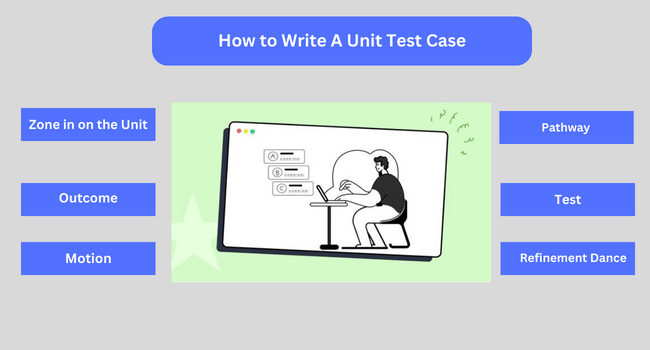In today’s fast-paced tech world, ensuring the reliability and functionality of software components is paramount. Enter the realm of ‘Unit Test Case.’ This essential tool helps developers maintain high-quality software, ensuring each component functions as intended.
Unit testing stands out in the vast realm of software testing. Its granular approach to testing individual components ensures robust software quality. By isolating each software piece, developers can pinpoint issues with precision.
This proactive approach prevents minor glitches from snowballing into significant software malfunctions. Moreover, unit test cases offer a structured approach to testing.
With precise inputs, expected outcomes, and execution processes, they eliminate ambiguity. Developers know what to expect and where to look if things go awry.
Dive in as we explore the intricacies of unit test cases, their importance, and how to craft them effectively.
What is the Unit Test Case?

A unit test case is a set of conditions or inputs used to determine whether a specific software component functions correctly. In essence, it’s a blueprint that describes the expected behavior of a particular unit of code.
When executed, the unit test case will either pass, indicating the code behaves as expected, or fail, pointing out potential issues. Delving into software development, one encounters the term ‘unit test case’ frequently.
A unit test case plays a pivotal role in ensuring software quality. At its core, a unit testing example test case evaluates the performance of specific software components.
Developers can gauge if a software piece operates as intended by setting predefined conditions or inputs. Let’s break down the concept further.
Defining the Unit Test Case
A unit test case isn’t just a term; it’s a methodology. Developers use it to verify the accuracy of individual software testing levels and components. Think of it as a litmus test for code.
The primary goal is ascertaining that a particular code segment delivers the desired output. If the code meets the expectations, the test case passes. Conversely, if the code falls short, the test case highlights the discrepancies.
Diving Deeper: Key Components Of Unit Tests
Every unit test case comprises several integral components. Each plays a distinct role in the testing process.
- Input: Every test begins with data. Developers provide specific inputs to the software component under scrutiny. This data serves as the starting point for the test.
- Expected Output: Developers have a clear vision of the desired outcome before running the test. This foresight is the ‘expected output.’ It’s the benchmark against which the software’s performance is measured.
- Actual Output: The software component produces a result once the test runs. This outcome, stemming from the provided input, is the ‘actual output.’ It’s the tangible result of the test.
- Execution: The crux of the testing process is execution. Here, the test runs, processing the input to produce an output. The magic moment is Comparing the expected and actual outcomes. If they align, it’s a win. If not, it’s back to the drawing board.
The unit test case is more than a buzzword in software development life-cycle. It’s a systematic approach to ensuring software reliability.
Focusing on individual components offers a detailed, in-depth view of software performance. In a world where software drives everything, the importance of such meticulous testing cannot be overstated.

Why Do We Write Unit Test Cases?
In the intricate world of software development, precision is paramount. Every line of code, every function, and every module plays a crucial role.
Amidst this complexity, unit testing example test cases emerge as a beacon of clarity and reliability. But why do developers invest time in writing these tests? Let’s delve deep into the reasons and the multifaceted advantages they offer.
1. Ensuring Top-Notch Quality
First and foremost, unit test cases are synonymous with quality assurance. Every software comprises numerous components, whether an app or a full-fledged system.
Each component, no matter how minor, has a role to play. A malfunction in even the tiniest module can trigger a cascade of failures. Unit test cases act as gatekeepers.
By rigorously testing each component, developers ensure that every part of the software operates flawlessly. When each unit passes its respective test, the overall software quality elevates.
2. Facilitating Seamless Maintenance
Software isn’t a one-time creation. Post-deployment requires regular updates, bug fixes, and enhancements. Maintenance becomes a recurring task. Here, unit testing example test cases prove invaluable.
By pinpointing issues at the earliest stages, these tests reduce the time and effort spent on debugging. Early detection translates to quicker fixes.
Instead of wading through thousands of lines of code, developers can zero in on the problematic unit swiftly. The result? A smoother, more efficient maintenance process.
3. Boosting Confidence in Refactoring
Software evolution is inevitable. As requirements change and technologies advance, code modifications become necessary. This process, known as refactoring, can be fraught with risks.
Changing one part of the code might inadvertently affect another. Unit test cases offer a safety net. Before and after refactoring, running these tests provides assurance.
If all tests pass post-refactoring, developers can be confident that the changes haven’t disrupted the software’s core functionality. This confidence accelerates the development cycle and encourages innovation.
4. Promoting Superior Design Practices
An often-overlooked advantage of unit test cases is their influence on design. When developers know that each component will undergo rigorous testing, they naturally gravitate towards cleaner, more modular designs.
A well-structured, modular code is easier to test. Each module, being independent, can be tested in isolation. This approach not only simplifies testing but also enhances code readability and reusability.
Over time, writing unit test cases fosters a culture of excellence in design.
5. Serving as a Living Documentation
Documentation is the backbone of any software project. It provides insights into the software’s functionality, design decisions, and usage guidelines. While traditional documentation is valuable, unit test cases add another layer of depth.
They offer a practical, executable form of documentation. By examining the test cases, one can understand the expected behavior of each software component.
For new team members or even for future reference, these tests provide a clear, hands-on guide to the software’s inner workings.
6. Incorporating Feedback Loops
Feedback is integral to improvement. In software development, feedback often comes as bug reports or system crashes. However, with unit test cases, feedback becomes instantaneous.
After writing a unit of code, developers receive immediate feedback upon testing. This rapid feedback loop facilitates iterative development. Developers can write, test, and refine code quickly, producing a more polished final product.
7. Enhancing Team Collaboration
Unit test cases also play a pivotal role in team dynamics. In large projects with multiple developers, consistency is crucial. When every developer writes and tests their units, it ensures uniformity in code quality.
Moreover, these tests act as a communication tool. Developers can easily understand, adopt, or integrate others’ components, knowing they’ve passed their respective tests.
8. Reducing Long-Term Costs
While writing unit test cases requires an initial investment of time, the long-term benefits far outweigh the costs. By ensuring quality, simplifying maintenance, and reducing post-deployment bugs, these tests lead to significant cost savings.
Instead of spending resources on extensive debugging or customer support for software riddled with issues, developers can focus on enhancements and innovations.
Unit test cases are more than just a technical formality. They embody the principles of diligence, foresight, and excellence in software development.
By ensuring quality, facilitating maintenance, boosting refactoring confidence, promoting superior design, and serving as dynamic documentation, they lay the foundation for robust, reliable software.
Such meticulous testing is paramount in an era where software drives businesses and impacts lives.

How to Write A Unit Test Case
In the realm of software data and analysis, precision and accuracy reign supreme. One tool that ensures both is the unit test case. A well-crafted unit test case verifies a software component’s functionality and serves as a benchmark for quality.
But how does one go about creating a compelling unit test case? Let’s embark on a step-by-step journey to understand this process.
Step 1: Zone in on the Unit
Every software application, be it simple or complex, comprises multiple units. Each unit performs a specific function, contributing to the software’s overall functionality.
The first step in crafting a unit test case is pinpointing the unit to be tested. One must focus on the smallest, inseparable part of the software. By isolating this unit, developers can ensure a thorough and focused test.
Step 2: Charting the Input Pathway
Once the unit is identified, the next step beckons: defining the input. Every unit processes data to produce a result. The nature and type of this data, or input, can vary.
It could be numerical values, strings, or even complex data structures. Determining the right input is crucial. The chosen data should be relevant and comprehensive enough to test the unit’s functionality across various scenarios.
Step 3: Envisioning the Outcome
With the input in place, developers must then turn their attention to the expected output. What result does one anticipate when the unit processes the given input? This foresight forms the crux of the testing process.
By setting a clear, well-defined expected output, developers establish a benchmark. This benchmark will later serve as the standard against the unit’s actual performance.
Step 4: Crafting the Test
The actual creation of the test case follows. Here, developers use specialized testing frameworks tailored to the programming language. These frameworks offer tools and libraries that simplify the test-writing process.
While crafting the test, developers must ensure it’s comprehensive. The test should check for the expected output and handle potential exceptions or errors the unit might encounter.
Step 5: Setting the Wheels in Motion
With the test case ready, execution is the next step. Running the test breathes life into the entire process.
As the test runs, the unit processes the input, producing an actual output. This output, a tangible result of the unit’s functionality, is key to the test’s success or failure.
Step 6: The Refinement Dance
Post-execution, the moment of truth arrives. Developers compare the expected output with the actual output. A match indicates success, signaling that the unit functions as intended.
However, discrepancies can arise. When the actual output deviates from the expected result, the test fails. But failure isn’t the end; it’s an opportunity. Developers must delve into the code, identifying the root cause of the discrepancy.
Refining the code or tweaking the test case can rectify the issue. This iterative process of testing and refinement ensures that the software component achieves the pinnacle of functionality and reliability.
Beyond these six steps, it’s essential to understand the overarching philosophy of unit testing. Crafting a unit test case isn’t a one-off task. As software evolves, so do its units.
New functionalities might be added, or existing ones might undergo modifications. In such scenarios, unit test cases must be revisited and revised. This dynamic nature ensures that the tests remain relevant and effective.
Writing a unit test case is both an art and a science. It demands a keen understanding of the software component, a systematic approach, and an eye for detail.
Developers can ensure top-tier software quality by meticulously identifying the unit, defining the input, determining the expected output, crafting the test, executing it, and refining it as necessary.
What is the Difference Between A Unit Test Case And A Test Case?
In the intricate tapestry of software development and testing, terminology plays a pivotal role. Two terms that often create confusion are ‘unit test case’ and ‘test case.’
On the surface, they might seem synonymous, but a deeper dive reveals stark differences. Let’s journey to demystify these terms and understand their unique characteristics.
Unit Test Case Explained
A unit test case stands as a sentinel for individual software components. When we talk about units, we refer to software’s most minor, inseparable parts.
Depending on the software’s architecture, these could be functions, methods, or procedures.
- Granularity is Key: The primary focus of a unit test case is granularity. It zeroes in on specific software components, ensuring each tiny part operates flawlessly.
- Component-Centric Approach: The goal is to validate the functionality of individual components. By isolating each component and testing it separately, developers can ensure that every part of the software performs its designated function.
- Developer’s Territory: The responsibility of writing unit test cases often falls on developers. They craft these tests during the development phase, ensuring that each component meets the desired standards as they build the software.
Test Case Unveiled
Venturing beyond individual components, we encounter the broader realm of test cases. A test case doesn’t restrict itself to specific units. Instead, it casts a broader net, encompassing the software or sizable chunks.
- Versatility in Application: Test cases exhibit versatility. They can be applied to any software level, individual components, integrated modules, or the entire application.
- Holistic Viewpoint: The primary objective of a test case is to ensure the software’s overall functionality. It checks if different software parts work harmoniously, delivering the desired user experience.
- Quality Assurance Takes the Lead: Crafting test cases are typically the domain of quality assurance (QA) professionals. Armed with a comprehensive understanding of the software’s requirements and user expectations, they design tests that gauge its overall performance.
Difference Between A Unit Test Case And A Test Case
| Aspect | Unit Test Case | Test Case |
| Focus | Targets specific software components. | Addresses software at any level. |
| Objective | Validates individual component functionality. | Validates overall software functionality. |
| Crafted By | Primarily developers. | Primarily quality assurance professionals. |
| Scope | Narrow, centered on units. | Broad, can encompass entire software. |
| Testing Level | Low-level testing. | Can range from low to high-level testing. |
Unit Test Case Examples
Unit testing, a fundamental aspect of software development, focuses on validating individual units or components of software. Developers can build upon a solid foundation by ensuring that each unit functions as intended.
Let’s explore some unit test case examples to understand this concept better.
1. Testing a Calculator’s Addition Function
A calculator, a quintessential tool, simplifies arithmetic for users. One of its primary functions is addition. Let’s delve into how one might test this function.
- Scenario: Ensure that the calculator accurately adds two numbers.
- Input Parameters: For our test, we’ll use two numbers: 5 and 3.
- Expected Outcome: Simple arithmetic tells us that 5 plus 3 equals 8. Thus, our desired outcome is 8.
- Actual Outcome: This is the result the calculator provides when we input our numbers and request an addition.
Test Execution:
- Begin by inputting the numbers 5 and 3 into the calculator.
- Select the addition function.
- Observe the result displayed.
- Compare this result with the expected outcome of 8.
Evaluation:
- Should the calculator display 8, our test is successful.
- Any deviation from this expected result indicates a potential issue with the addition function.
2. Testing A Login Function
In the digital age, security is paramount. Login functions serve as gatekeepers, ensuring authorized access to platforms. Testing this function is crucial to maintain security and user trust.
- Scenario: Validate that the system grants access only when provided with the correct login credentials.
- Input Parameters: We’ll use a predefined correct username and password for this test.
- Expected Outcome: The system should grant access when presented with accurate credentials, signaling a successful login.
- Actual Outcome: This refers to the system’s response after inputting the provided credentials.
Test Execution:
- Navigate to the login page of the platform.
- Enter the correct username and password.
- Initiate the login process.
- Observe the system’s response.
Evaluation:
- Our test is deemed successful if the system grants access, indicating a successful login.
- Conversely, if access is denied despite correct credentials, there’s a flaw in the login function.
Further Considerations:
While the above examples provide a basic understanding, real-world scenarios often involve more complexities. For instance:
Calculator Function:
- What if one or both inputs are negative?
- How does the calculator handle decimal numbers?
- Is there an upper limit to the numbers the calculator can process?
Login Function:
- How does the system respond to multiple failed login attempts?
- Does the system differentiate between incorrect usernames and passwords?
- Are there security measures like CAPTCHAs to deter automated login attempts?
Wrapping up
Unit test cases are indispensable in the tech realm. They ensure software reliability, ease maintenance, and bolster confidence in code modifications. Developers can ensure top-notch software quality by understanding their nuances and crafting them effectively.
Unit test cases play a pivotal role in software development. They ensure that each component, no matter how small, functions optimally. By breaking down the software into individual units and testing each rigorously, developers can ensure overall software robustness.
The examples provided, though simplistic, underscore the importance of meticulous testing. They highlight the need to consider various scenarios, inputs, and outcomes. Unit testing is the unsung software development hero, ensuring the foundation is solid and reliable.
The ‘Unit Test Case’ is a beacon of quality assurance in the tech world. By understanding its intricacies and leveraging its power, developers can craft software that’s functional and reliable.
As the tech landscape evolves, the importance of unit test cases will only grow, solidifying their place as an essential tool in a developer’s toolkit.
Frequently Asked Questions
Why are unit test cases crucial in agile development?
In agile development, frequent changes are the norm. Unit test cases ensure these changes don’t introduce new bugs, maintaining software quality throughout the development cycle.
How often should unit test cases be run?
Ideally, unit test cases should be run after every code change. It ensures that any introduced changes don’t adversely affect existing functionality.
Can unit test cases replace manual testing?
While unit test cases are robust, they can’t replace manual testing entirely. Manual testing captures nuances and user experiences that automated tests might miss.
- Top 10 Cross Browser Testing Tools: The Best Choices for 2024 - October 28, 2025
- 5 Best API Testing Tools: Your Ultimate Guide for 2024 - October 26, 2025
- Top 5 Regression Testing Tools: Comprehensive Review & Guide - October 26, 2025
